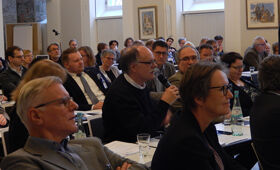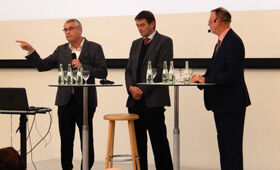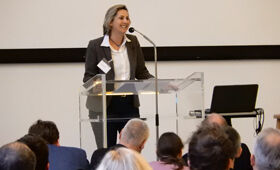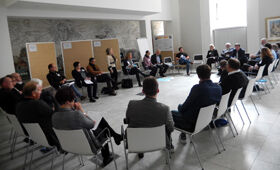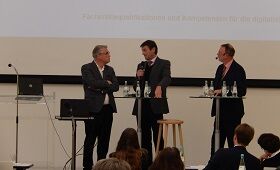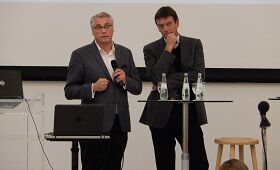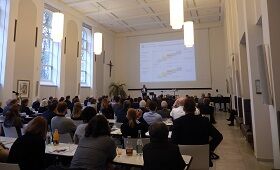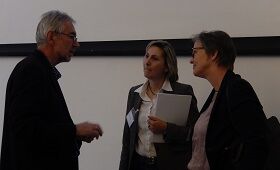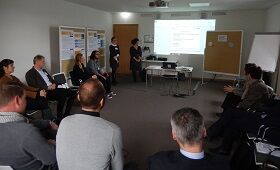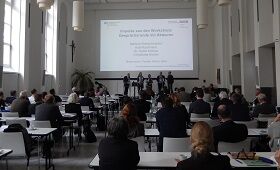Vocational education and training 4.0 – skilled worker qualifications and competencies for the digitalised work of the future – key findings presented at symposium
Key findings from the initiative entitled “Qualifications and competencies of skilled workers for the digitalised work of tomorrow”, which has been implemented as a joint initiative by the Federal Ministry of Education and Research (BMBF) and the Federal Institute for Vocational Education and Training (BIBB), were presented and discussed in the context of Vocational Education and Training 4.0. at a symposium in Bensberg near Cologne.
The initiative focused on three priorities: selected occupational screening, a medium-term skilled worker forecast, and the media-pedagogical and digital competencies required of training personnel.
The outcome of all project phases reveals a consistent pattern showing that the impact of digitalisation is already significant in terms of both the future demand for the skilled workers and vocational education and training. The pace of this process is set to accelerate in the future and further far-reaching changes are to be anticipated.
Occupational screening – occupational profiles in need of redefinition
Findings from the occupational screening show that the process of “digital” penetration in training occupations is occurring at different rates dependant on the company and that the process also differs completely in terms of depth and rigour, including between occupations. Digitalisation has arrived in all fourteen of the occupations investigated. On average, only one in three of the skilled workers, trainers, skilled worker superiors and training managers surveyed already assess the degree of digitalisation in the workplaces of the occupations in question as high. In many cases, therefore, changes to training regulations, e.g. the inclusion of additional qualifications and mandatory optional modules, are initially recommended for a transition phase.
It is also apparent that increasing digitalisation is accompanied by a further shift in the expectations regarding the core competencies of skilled workers. Occupational professional competence remains important; the use of information and communication technologies, digital work and IT security are becoming increasingly incorporated within work tasks; process and system understanding are called for, as are independent and ongoing learning, flexibility, and problem solving and communication skills.
These 14 occupations were investigated:
- Plant mechanic for sanitary, heating and air conditioning Systems
- Farmer
- Agricultural services specialist
- Warehouse Operator
- Warehouse logistics Operator
- Industrial Clerk
- Agricultural and construction machinery mechatronics engineer
- Machine and plant operator specializing in food Engineering
- Machine and plant operator specializing in textile engineering and specializing in textile finishing
- Audiovisual media Producer
- Designer of digital and print media
- Orthopaedic technician
- Road builder
- Sewage engineering technician
- Mechanic in plastics and rubber processing
Skilled worker forecasts – distinct shifts in the labour force structure as a result of digitalisation
According to experts, a more systematic and sustainable monitoring of training occupations is necessary in future.
Training should be more regularly scrutinised and further developed on a regional basis by means of improved learning location cooperation. This will necessitate both improved general conditions and a changed perception of roles on the part of stakeholders at management level. The changed demands placed on training personnel will also have to take effect.
As part of regulatory work, a fundamental redefinition of many occupational profiles will be unavoidable in the medium term.
In most of the training occupations investigated, the demand for skilled workers who have qualified through vocational education and training is assessed as increasing or at the very least as stable. This was shown by both the results of the occupational screening as well as the skilled worker forecasts conducted.
The latest results from the skilled worker forecasts, in this case in particular the BIBB-IAB qualification and occupational field projections, point to a temporary increase in the population figure by 2035 due to gains from immigration. However this will not cause any increase in unemployment despite the increase in labour supply. Instead, the labour market is characterized by a shortage of persons in gainful employment. Not only is the demographic change causing increased internal demand for goods and services, but it is also changing the labour force structure in terms of occupations. In 2035, in the health sector will have the most employees, while at the same time, the greatest shortages, in absolute terms, will emerge in the medical health care occupations. On the other hand, agricultural occupations are losing their appeal, which means shortages also occur here.
The greater impact of digitalisation means that in 2025 around 1.3 million of today’s jobs will no longer exist, while around 2.1 million new jobs will be created. By 2035 the structural transformation will be even greater, and almost 3.3 million jobs will be created by then as a result of digitalisation. Over the same period however, 4 million jobs will disappear. In relation to today’s workforce figure of almost 45 million, 16% of all jobs (7.3 million = (3.3 million, -4.0 million ) will be different in the labour market of the future and in 2035 there will be 740,000 fewer jobs than there are today. However, a digitalised world of work is not the sole driver behind this transformation. There will also be a smaller working population due to demographic factors.
Training personnel – general and pedagogic media competence are the key to the work of trainers
In addition to occupational screening and skilled worker forecasts, the initiative’s third priority was the definition of media-pedagogical competency required of training personnel.
In view of the new opportunities associated with digitalisation for IT-based information, communication and (mobile) cooperation, both training personnel in all learning locations as well as trainees consequently feel that they are having to face up to new competency requirements.
In view of the ever-present debate surrounding the digital transformation of the economy and of society, the arbitrary use of “media competency” in a range of different connotations was very surprising. Descriptions such as “computer knowledge”, “IT competency”, “media competency” or even “user competency” are frequently applied synonymously, even though they may have very different meanings in the context of training young people and young adults. With the aid of a synopsis, specific definitions of terms were therefore initially researched, integrated within current academic discussion and related to one another. A proposal for a definition of (vocational) media and IT competence was then submitted.
Alongside this definition of terms, BIBB developed a model of media-pedagogical competence for training personnel. It was created as part of a research project by BIBB and was developed in cooperation with trainers in order to define, using a case study approach, the expertise for this target group which they can use to deliver and develop vocational media and IT competence in day-to-day training in a domain-specific and practical manner. The model provides an acquisition process, conceived as an ideal, which sets out the possible didactic framework for a continuing training format appropriate for the training personnel.
Approach serves as guide for further activities
These findings are the result of two and a half years of work in the project team, which has been supported significantly by the specialist knowledge and experience of the experts involved and by the regular exchange with academics, practitioners and political decision makers.
More than a dozen occupations have now been closely examined as part of the occupational screening. For this purpose, information was evaluated, a large number of case studies were conducted, and interim results generated from these as part of an online survey were placed in a broader context and compared against the applicable regulatory instruments.
Further work will be carried out on the thematic priority of VET 4.0 in the future. This will occur both implicitly in many ongoing projects and schemes, as well as in new initiatives currently being prepared.
Publications:
- Härtel, Michael; Averbeck, Ines; Brüggemann, Marion; Breiter, Andreas; Howe, Falk; Sander, Michael: Medien- und IT-Kompetenz als Eingangsvoraussetzung für die berufliche Ausbildung – Synopse WDP 193, BIBB, Bonn, 2018
- Härtel, Michael, Brüggemann, Marion, Sander, Michael, Breiter, Andreas, Howe, Falk, Kupfer, Franziska: Digitale Medien in der betrieblichen Berufsbildung – Medienaneignung und Mediennutzung in der Alltagspraxis von betrieblichem Ausbildungspersonal, WDP 196, BIBB, Bonn, 2018
